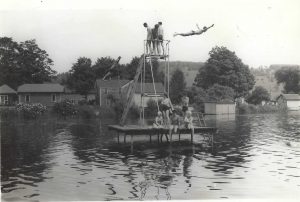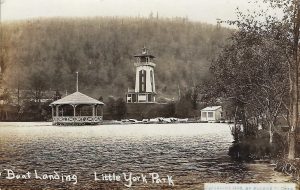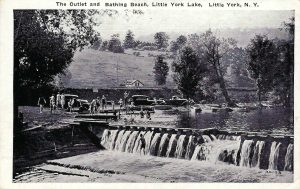It is a reality in Central New York that the official coming of spring does not banish the possibility of snow, as we were reminded this week! It certainly makes one long for summer sunshine and warmth, barbeques, and fun in the great outdoors.
A long-time favorite spot of Cortlandites for such activities is of course Little York Lake!
The history of Little York Lake and the surrounding area begins of course with the Haudenosaunee who it is said had a legend about the nearby Mt. Onagarechny (Mt. Toppin) as the location where pumpkins, corn, and tobacco first grew and were discovered. This legend was noted by Conrad Weiser, an interpreter who we believe was the first white man to view the mountain in April of 1737.
Other legends surrounded the lake in later years, including the existence of a medicinal spring that endowed the imbiber eternal youth free of pain or sickness, as well as tales of the ruins of an ancient civilization at the bottom of the lake. The latter rumor became quite a topic of interest in the 1870s.
When white settlers arrived in the latter part of the 18th century, the lake became the location of several mills. Beginning in the 1890s, the lake became a source for the big business of harvesting and selling ice. The park with its magnificent pavilion was originally owned and operated by the Cortland County Traction Company which also ran the trolleys. The pavilion was planned and built in 1906, and ever since then, Little York Park has been a go-to location for concerts, dances, swimming, fireworks, picnics, family reunions, and just about any kind of outdoor fun you can imagine. I even found a newspaper article about a lady who gave a performance on the piano inside a cage with five leopards that accompanied her on musical bells!
When the Traction Co. went out of the electric railway business in 1931, the park was sold and abandoned. Ten years later, guided by a public referendum the county bought the park, and plans were made for restorative work.
In the CCHS archives can be found the postwar public works plan for the park that was drawn up by William J. Dwyer, superintendent of Highways. Work began in 1951 and the park reopened in 1952. CCHS also possesses the 1955 plan for the miniature train. known as Tiny Mite, which became an amusement attraction. The pavilion is now listed on the National Register of Historic Places and after over one hundred years is still used as the summer theater for Cortland Repertory Theatre.
Little York Lake has been the scene of much memory-making that continues to this day!
To warm days to come! ~Sophie, Collections and Research Assistant





Comments are closed, but trackbacks and pingbacks are open.